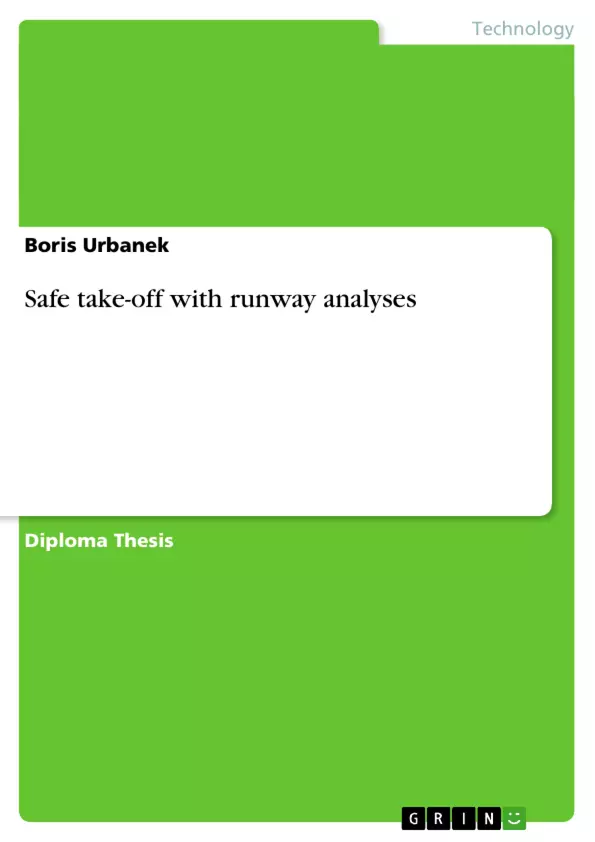The economic situation of recent years forces to operate at highest payloads possible and therefore maximum allowable take-off masses of an aircraft. An optimization of the take-off performance plays important role as never before. The take-off performance data for several flight and ambient conditions are usually presented in so called runway analyses. This paper answers possible questions about their application and computing, which may interest a personnel of flight engineering departments or pilots. Moreover, this thesis offers a summary of factors affecting the maximum take-off mass and appropriate take-off speeds, which together represent necessary performance data for a safe take-off. Particular sections describe a principle of the optimization process and offer a designed conceptual model in a form of flowcharts according to which it is possible to perform a calculation for various aerodrome or weather conditions. The created conceptual model may also serve as a core for the software application, which reduces the time required to do the calculation manually.
Inhaltsverzeichnis (Table of Contents)
- ABSTRACT
- ABSTRAKT
- 1 INTRODUCTION
- 1.1 Purpose of Thesis
- 1.2 Scope of Thesis
- 1.3 Methodology
- 2 AIRCRAFT PERFORMANCE FOR TAKE-OFF
- 2.1 Performance Parameters
- 2.2 Factors Affecting Take-off Performance
- 2.2.1 Airport Elevation
- 2.2.2 Runway Characteristics
- 2.2.3 Meteorological Conditions
- 2.2.4 Aircraft Configuration
- 2.2.5 Aircraft Weight
- 3 TAKE-OFF PERFORMANCE OPTIMIZATION
- 3.1 Take-off Performance Calculation
- 3.1.1 Take-off Distance and V1 Calculation
- 3.1.2 Calculation of Required Runway Length
- 3.2 Optimization of Take-off Performance
- 3.2.1 Factors Affecting Maximum Take-off Mass
- 3.2.2 Aircraft Weight and Performance Optimization
- 4 RUNWAY ANALYSIS AND ITS APPLICATION
- 4.1 Definition of Runway Analysis
- 4.2 Application of Runway Analysis
- 4.3 Runway Analysis for Take-off
- 4.3.1 Flight Engineer's Point of View
- 4.3.2 Pilot's Point of View
- 5 APPLICATION FOR TAKE-OFF PERFORMANCE ANALYSIS
- 5.1 Conceptual Model for Take-off Performance Optimization
- 5.2 System Requirements for Take-off Performance Calculation
- 5.2.1 Input Data
- 5.2.2 Processing and Calculation
- 5.2.3 Output Data
- 6 CONCLUSION
- 7 LITERATURE
- 8 APPENDICES
Zielsetzung und Themenschwerpunkte (Objectives and Key Themes)
This Master's thesis investigates the application of runway analysis for take-off performance optimization, aiming to provide a comprehensive understanding of the factors influencing aircraft performance and the process of maximizing take-off weight while maintaining safety.- Aircraft Performance for Take-off: Exploring the key performance parameters, factors affecting take-off performance, and the relationship between aircraft weight and performance.
- Take-off Performance Optimization: Delving into the methods for calculating take-off distance and required runway length, and exploring strategies for optimizing take-off performance to achieve maximum take-off mass.
- Runway Analysis and its Application: Defining runway analysis and its applications in different contexts, highlighting the perspectives of flight engineers and pilots.
- Conceptual Model for Take-off Performance Optimization: Presenting a conceptual model for optimizing take-off performance, outlining the input data, processing, and output data required for the calculation.
- Software Application: Examining the potential of developing a software application based on the conceptual model to automate the calculation of take-off performance data.
Zusammenfassung der Kapitel (Chapter Summaries)
The first chapter introduces the purpose, scope, and methodology of the thesis. Chapter 2 explores the performance parameters relevant to take-off, and analyzes factors such as airport elevation, runway characteristics, meteorological conditions, aircraft configuration, and weight, which all impact aircraft performance. Chapter 3 focuses on the optimization of take-off performance, including the calculation of take-off distance and required runway length, as well as strategies for maximizing take-off weight. Chapter 4 examines the definition and application of runway analysis, emphasizing the perspective of flight engineers and pilots. Chapter 5 presents a conceptual model for optimizing take-off performance, outlining the input data, processing, and output data required for the calculation, and discusses the potential for developing a software application to automate this process.
Schlüsselwörter (Keywords)
The primary focus of this Master's thesis lies on runway analysis, aircraft performance, maximum take-off mass, take-off speeds, and take-off optimization. The thesis aims to provide a thorough analysis of these elements and their implications for safe and efficient take-off operations.- Arbeit zitieren
- Boris Urbanek (Autor:in), 2012, Safe take-off with runway analyses, München, GRIN Verlag, https://www.hausarbeiten.de/document/195384


